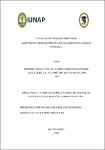Deforestación y uso de la tierra mediante imágenes satelitales, en la carretera Iquitos Nauta 1989 – 2017
Abstract
El área de influencia de la carretera Iquitos Nauta, es un sector de la Amazonia andina que se encuentra bajo la fuerte presión que ejercen las poblaciones sobre sus recursos naturales, especialmente las ciudades de Iquitos y Nauta. Las actividades antrópicas desarrolladas están afectando los suelos y la biodiversidad, considerando que su potencial es para uso forestal y las áreas de potencial agrícola se restringen a pequeños sectores localizados en las llanuras aluviales y complejo de orillares. El objetivo fue determinar la tasa de deforestación anual, calcular y cuantificar el uso de la tierra y determinar la relación que existe entre la deforestación y el cambio de uso de la tierra, mediante la utilización de imágenes satelitales entre los años 1989 – 2017. Se utilizaron imágenes satelitales Landsat 8, 5 y 4, con sus sensores OLI, ETM y TM, como fuente de información, seleccionándose las imágenes, sensores, nubosidad y la fecha de toma de las mismas. La metodología aplicada se basó en técnicas de análisis, procesamiento digital e interpretación visual, tomando en consideración la respuesta espectral de los diferentes tipos de vegetación, usos del suelo y deforestación. Los resultados obtenidos fueron la identificación y cuantificación del uso de la tierra y la deforestación del área de estudio. Se identificaron siete clases de uso de la tierra; agricultura, pastos cultivados y mejorados, centros urbanos, bosque primario, bosques secundarios, purmas y cuerpos de agua. Las áreas deforestadas para el año 1989 alcanzó a 41,988 ha, para el año 1995 fue de 58,668 ha, mientras que para el año 2005 fue de 68,896 ha y para el año 2017 comprendió un área de 91,181.18 ha. Finalmente, la tasa de deforestación anual para el periodo de 28 años analizado fue de 1,756.89 ha por año. The area of influence of the Iquitos Nauta road is a sector of the Andean Amazon that is under the strong pressure exerted by the populations on their natural resources, especially the cities of Iquitos and Nauta. The anthropic activities developed are affecting soils and biodiversity, considering that their potential is for forest use and areas of agricultural potential are restricted to small sectors located in the floodplains and complex of banks. The objective was to determine the annual deforestation rate, calculate and quantify the use of the land and determine the relationship between deforestation and the change of land use, using satellite images between 1989 y 2017. It used Landsat 8, 5 and 4 satellite images, with their OLI, ETM and TM sensors, as a source of information, selecting images, sensors, cloudiness and the date they were taken. The methodology applied were based on analysis techniques, digital processing and visual interpretation, taking into account the spectral response of the different types of vegetation, land use and deforestation. The results obtained were the identification and quantification of land use and deforestation of the study area. Seven kinds of land use were identified; agriculture cultivated and improved pastures, urban centers, primary forest, secondary forests, purges and bodies of water. The deforested areas for 1989 reached 41,988 hectares, for 1995, it was 58,668 hectares, while for 2005 it was 68,896 hectares and for 2017 it included an area of 91,181.18 hectares. Finally, the annual deforestation rate for the 28-year period analyzed was 1,756.89 hectares per year.
Collections
- Tesis [500]
The following license files are associated with this item:


